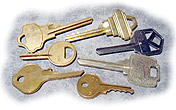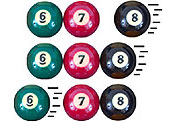Lock Bumping
What is a bump key?

A bump key is made by taking any regular key and modifying it with common household tools. There's a good chance the locks you have on your front door are vulnerable to a bump key. A bump key will open most locks that the key can physically slide into.
How does a bump key work?

A bump key works on basic physics. Imagine a set of 3 billiard balls on a pool table, all touching each other. When you tap the first ball with the cue ball, what happens? The last ball moves away. The bump key works on the same principle. When the bump key is inserted into the lock and then tapped with a small hammer, the impact of the hammer travels through the key into the bottom pins in the lock, and then to the top pins in the lock. Since the top pins are only supported by springs, the springs compress and the top pins "jump" for a fraction of a second. In that short timeframe that the lock can be opened. Although it might sound complicated it's really very easy.
How easy is it to use a bump key?
With the proper motivation and opportunity, its' very easy to use a bump key. Video sharing websites like youtube.com and video.google.com have videos of young men demonstrating their bump key abilities, and how easy it really is. Although they are showing themselves opening their own front door, think of the countless many that have learned how to use a bump key and decided it would be "fun" to open their neighbour or friend's doors?
Why is a bump key such a threat?
A bump key is a threat because it can be used as a burglary tool -- it can be made easily from any key (not just keyblanks), and the instructions are all over the internet on how to make one.. Unfortunately, bump keys are also easily available for sale online and from auction sites. Generally lockpicks and other locksmith tools are difficult to obtain and use, but the bump key is easy to make and requires very little skill to use.
What type of locks are vulnerable to a bump key?
Literally millions of locks all over the world are vulnerable. All keyed locks sold in common hardware stores can be opened with a bump key. Deadbolts, knobsets, leversets, rim cylinders, mortise cylinders, and most padlocks are also vulnerable to attack. When the packaging for a lock includes phrases like "Extreme Security, High Security, Pick-Resistant Pins, ANSI Grade 2" or even our favorite "The Best Security You Can Buy", it does not necessarily mean the lock is bump-proof. Basically, if you bought your lock from a hardware store it's vulnerable to a bump key attack. Most locks from locksmiths are also vulnerable. If you did not specifically purchase a UL High Security lock from a locksmith, it is probably vulnerable.
Bump proof solutions
For less frequently used doors like the ones on the side of a garage, you can purchase a solid slide bolt lock which will prevent the door from opening from the outside. Of course, the solution for the door that you use to enter and exit your home or business is to replace the lock with a high-security lock. High security locks provide additional layers of protection against picking, drilling, and of course bumping. Each of the manufacturers that we represent has built in their own technology that thwart the bump key's effectiveness, and also offer drill protection, extreme pick resistance, and key control.

